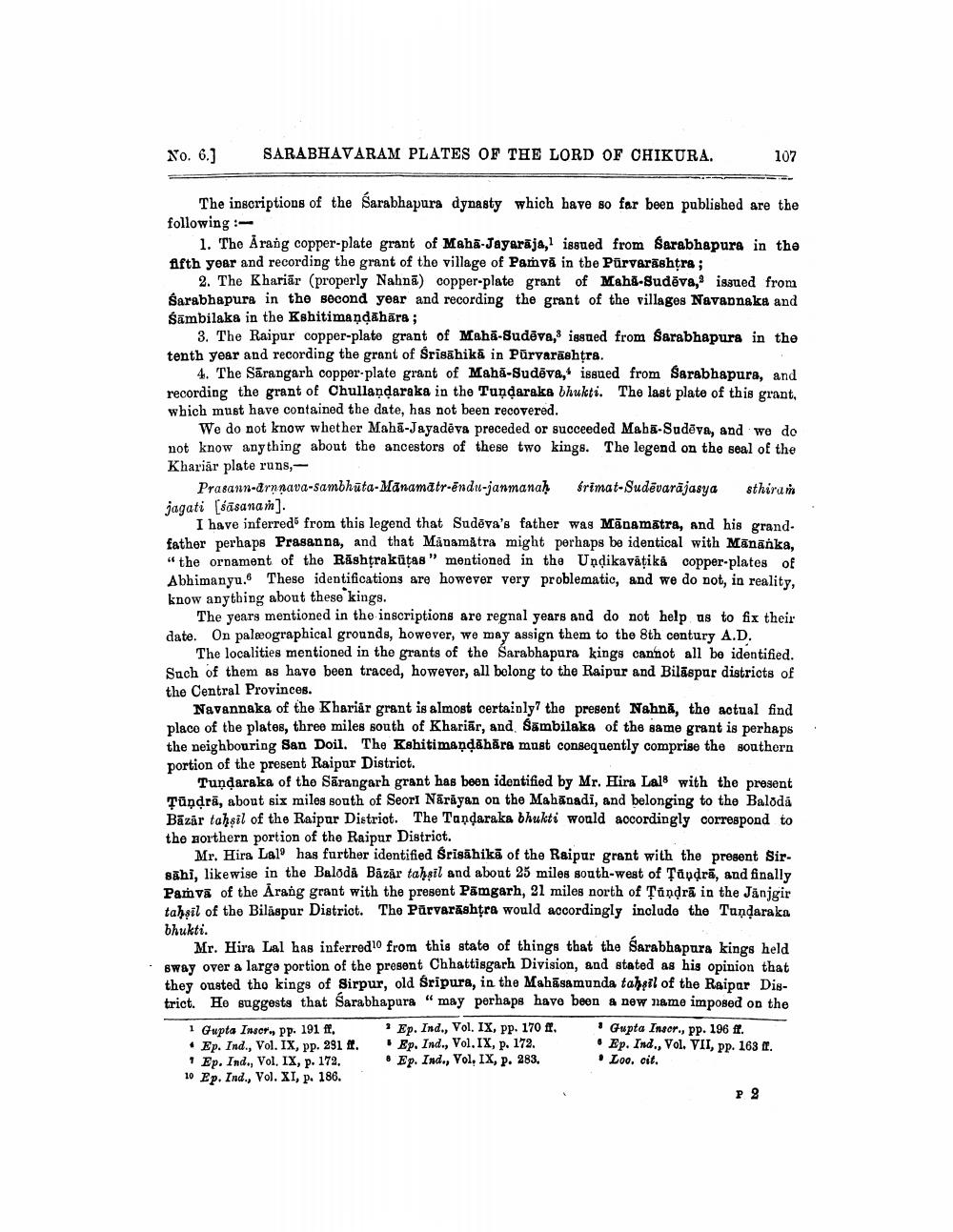________________
No. 6.]
SARABHAVARAM PLATES OF THE LORD OF CHIKURA.
107
The inscriptions of the Sarabhapura dynasty which have so far been published are the following:
1. The Arang copper-plate grant of Mahā-Jayarāja, issued from Sarabhapura in the Afth yoar and recording the grant of the village of Pamvă in the Purvarishtra;
2. The Khariār (properly Nahn) copper-plate grant of Mahd-Sudēva, issued from Sarabhapura in the second year and recording the grant of the villages Navadnaka and sambilaka in the Kshitimandahāra;
3. The Raipur copper-plate grant of Mahā-Sudēva, issued from Sarabhapura in the tenth year and recording the grant of Śrīsāhikā in Pürvarishtra.
4. The Sārangarh copper-plate grant of Mahā-Sudēva, issued from Sarabhapura, and recording the grant of Chullandaraka in the Tuņdaraka bhukti. The last plate of this grant, which must have contained the date, has not been recovered.
We do not know whether Mahā-Jayadeva preceded or succeeded Maba-Sudēva, and we do not know anything about the ancestors of these two kings. The legend on the seal of the Khariär plate runs, -
Prasann-drnnava-sambhuta-Manamatr-ēndu-janmanah Srimat-Sudēvarājasya sthirun jagati [šāsanam).
I have inferred from this legend that Sudēva's father was Mānamatra, and his grandfather perhaps Prasanna, and that Manamåtra might perhaps be identical with Mānāńka, “the ornament of the Răshţrakūtas " mentioned in the Undikavāţiká copper-plates of Abhimanyu. These identifications are however very problematic, and we do not, in reality, know anything about these kings.
The years mentioned in the inscriptions are regnal years and do not help us to fix their date. On paleographical grounds, however, we may assign them to the 8th century A.D.
The localities mentioned in the grants of the Sarabhapura kings cannot all be identified. Such of them as have been traced, however, all belong to the Raipur and Bilaspur districts of the Central Provinces.
Navannaka of the Khariär grant is almost certainly the present Nahna, the actual find place of the plates, three miles south of Khariār, and Sambilaka of the same grant is perhaps the neighbouring San Doil. The Kshitimaņdāhāra must consequently comprise the southern portion of the present Raipur District.
Tundaraka of the Sārangarh grant has been identified by Mr. Hira Lale with the present Tündrā, about six miles south of Seori Nārāyan on the Mahanadi, and belonging to the Baloda Bāzār tahsil of the Raipur Distriot. The Taņdaraka bhukti would accordingly correspond to the northern portion of the Raipur District.
Mr. Hira Lal' has further identified Grisāhikā of the Raipur grant with the present Sirsahi, likewise in the Baloda Bazar tahsil and about 25 miles south-west of Tapdrā, and finally Pamvā of the Arang grant with the present Pāmgarh, 21 miles north of Tandra in the Janjgir tahsil of the Bilaspur District. The Pārvarashtra would accordingly include the Tundaraka bhukti.
Mr. Hira Lal has inferred 10 from this state of things that the Sarabhapura kings held • sway over a larga portion of the present Chhattisgarh Division, and stated as his opinion that
they ousted tho kings of Sirpur, old Sripura, in the Mahāsamunda tahsil of the Raipar District. He suggests that Sarabhapura " may perhaps have been a new name imposed on the 1 Gupta Inscr, PP. 191 ff.
Ep. Ind., Vol. IX, pp. 170 ff, 'Gupta Insor., pp. 196 ff. • Ep. Ind., Vol. IX, pp. 291 #. Ep. Ind., Vol. IX, p. 172.
Ep. Ind., Vol. VII, pp. 163 r. Ep. Ind., Vol. IX, p. 172. Ep. Ind., Vol. IX, p. 283.
Loo. cit. 10 Ep. Ind., Vol. XI, p. 186.




